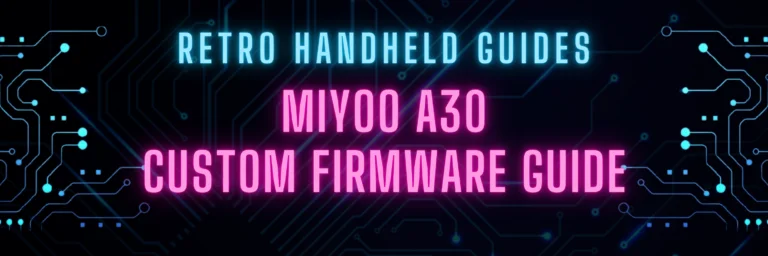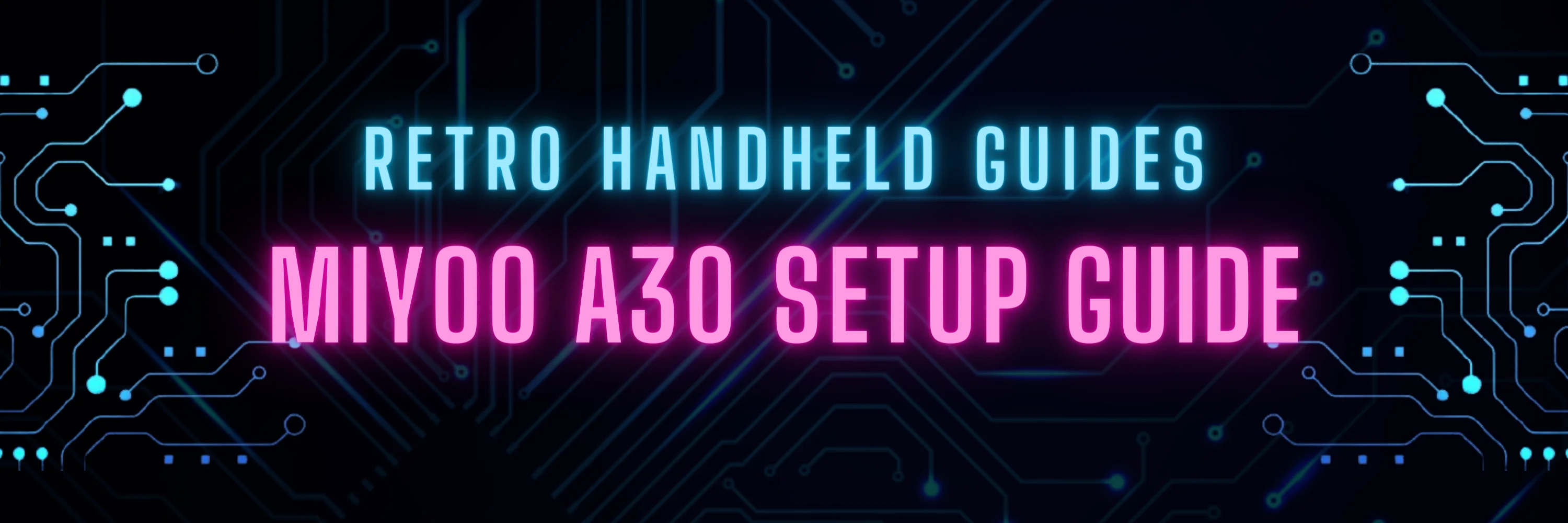Miyoo A30 Setup Guide
The Miyoo A30 is a very small, horizontal form factor retro handheld. With a 2.8″ IPS screen, the Miyoo A30 is designed to be ultra-portable but powerful enough to run even some N64, Dreamcast and PSP games.
While the Miyoo A30 is not powerful enough to run every game in the N64, Dreamcast or PSP catalogue, it is capable of running a good portion of them.
Released at the same time as the Anbernic RG28XX, the Miyoo A30 aims to compete in this ultra compact, low budget category and differentiates itself from the RG28XX with the addition of a single joystick which makes it a better choice for those higher end systems that used one originally.
In this Miyoo A30 Setup guide, I will show you how to get the most out of the device as well as provide you with some of my own tips and tricks to maximizing performance.
Where to Buy the Miyoo A30
- Miyoo Official Store on AliExpress (limited quantity)
Miyoo A30 Orientation
The first thing that we need to do is get familiar with the basics of using the Miyoo A30. In the sections that follow, I will teach you everything you need to know about basic navigation and the external buttons.
How to Turn On the Miyoo A30
The Miyoo A30 has a standard power button on the right hand side of the device. To turn on the Miyoo A30, simply hold down the power button for 3-5 seconds until the second blue LED lights up and the Miyoo logo is displayed.
If you are having trouble turning on the device, check the following:
- Is the battery charged?
- Is the OS micro SD card inserted into the SD card slot on the bottom of the device?
- Has the SD card become corrupted?
How to Turn Off the Miyoo A30
The Miyoo A30 can be turned off at any time using the Power button on the right hand side of the device.
When at the main menu, pressing and holding the Power button for 3 seconds will display a Power off prompt. Pressing A will power off the device from here or pressing B will cancel the shutdown sequence.
While in a game, pressing and holding the power button for 3 seconds will return you to the main menu. If you continue to hold the power button for an additional 5 seconds, the device will eventually power off.
You can also power off the device from the main menu by navigating to the Settings menu and selecting the Power Off menu item at the top of the list.
How to Exit a Game on the Miyoo A30
While in a game, pressing the home button on the top of the device next to the L2 button will bring up a system menu. The last option in this menu is Exit Game which will return you to the main menu.
Alternatively, pressing and holding the power button for 3 seconds will eventually return you to the main menu as well.
Miyoo A30 Save State and Load State
The Miyoo A30 supports save states and load states in all supported emulators. To quickly create a save state on the Miyoo A30, while in a game, simply press the Home button on the top of the device and scroll down to the Save menu item.
From here you can use the left and right dpad to select a “save slot” allowing you to make up to 10 unique save states per game.
To Load a save state, while in a game, simply press the Home button and navigate to the Load menu item and select the save state to load.
How to access Retroarch settings on Miyoo A30
The Miyoo A30 setup is primarily built around the Retroarch cores. If you are familiar with Retroarch or would like to do some more advance tweaking to the system like adding shaders and filter, changing the button mapping, or tweaking core settings for performance, you will need to do that through Retroarch.
To access the Retroarch menu, while in a game you can press the Home button and navigate to the Native Menu option. This will bring up the Retroarch menu.
You can also directly access Retroarch for general settings from the Menu menu by navigating to the Apps section and selecting RetroArch.
How to add games to the Miyoo A30
There are two primary ways to add your own games to your Miyoo A30 setup
Via SD Card
The first way is to remove the micro SD card from the bottom of the device and pop it into your computer. The micro SD card is a standard FAT32 formatted card and should be easily read by any PC.
Via USB-C cable
We can also access the internal storage to add our own games by turning on the Miyoo A30 and connecting it to our PC via the provided USB C to A cable.
Once connected and turned on, navigate to the Apps menu and select USB Storage. This makes the Miyoo A30 act just like a standard USB thumb drive and the contents of the micro SD can then be managed from any PC.
Copying Games to the SD card
Whether you choose to insert the micro SD directly into your PC or via the USB Storage option on the Miyoo A30, once you have access to the contents, it is easy to add your own games.
To add games to the Miyoo A30, place your game ROMS into the corresponding emulated system folder under the ROMS folder.
Inside the ROMS folder are sub-folders for each emulated system. Some of these shorthand names might not be intuitive if you grew up in North America.
FC = Famicon = Nintendo Entertainment System
SFC = Super Famicon = Super Nintendo
MD = Mega Drive = Sega Genesis
How to refresh the games list
Once the new games have been added to the SD card, from the main menu we need to press the Home button and select the Refresh Roms menu item.
This will then rescan the SD card and add/remove games from the game lists.
How to enable Wifi on the Miyoo A30
The Miyoo A30 is capable of Wifi. To enable it, navigate to the Settings menu and look for the WIFI option.
Use the dpad to turn WIFI ON then select your Wifi network.
This will bring up a virtual keyboard where we can now enter the WIFI password. Unfortunately, there is no way to see the actual password we are typing in so you’ll just have to make sure you get it right by memory.
Miyoo A30 Firmware Update
Be sure to check out my Miyoo A30 Custom Firmware Guide for alternative operating systems available for the Miyoo A30.
Official Miyoo Firmware
Miyoo has already released a firmware update which will fix the dim screen issue that was seen in the first batch of devices. To check to see if you have an older firmware and need to update, go to the settings menu and scroll to Device Info.
The firmware version number contains the date as part of the version code and so if your firmware is less than 20240426.. then you should update.
Miyoo A30 20240426 Firmware Download link: https://mega.nz/folder/oOE1RIRK#ny8vRYs_9YOzIdirhWGYTg
To install the firmware, simply extract the .img file from the .zip package and place the file in the root of your SD card.
Next, plug in your device to a charger and turn it on. You should see a rocket icon and a message indicating that the firmware is updating. Keep the device plugged in during the update.
When the update is complete, the device will turn off.
An update to fix the original performance issues with various Retroarch cores has also been released. Download the new SD card image from the link below
Miyoo A30 240501 SD Card Image Download Link: https://mega.nz/folder/EXlCQRxK#ClK1FZKtMhUqArx3oWUlBA
Using a new 64GB (or larger) SD card, copy the contents of this zip archive directly to that SD card.
Miyoo A30 Performance Tips
How to Overclock the Miyoo A30
The Miyoo A30 comes with an easy to use overclock function built into the firmware.
Keep in mind that overclocking the Miyoo A30 will be more energy intensive and therefore cause the battery to drain more quickly while you are using it. This means shorter play time as well as possibly shortening the battery life on the device.
While overclocking my Miyoo A30, I also noticed that the device got much warmer while playing games. Not necessarily uncomfortably warm but definitely noticable.
Overclocking the Miyoo A30 should only be necessary for the more advanced emulated systems that the device is capable of like N64, Dreamcast or PSP.
To overclock the Miyoo A30, navigate to the Settings menu and scroll down to the CPU Frequency option. Press left or right on the Dpad to set the frequency higher than default. The higher the number, the better the performance.
Remove Video Filters
Unfortunately, the Miyoo A30 setup suffers from bad Retroarch configurations out of the box which causes many of the emulators to have much worse performance than the device is capable of.
Emulation of SNES games is a prime example of this poor configuration causing performance of this system to be pretty bad out of the box.
To improve SNES performance on the Miyoo A30, press the Home key and navigate to the Native Menu (Retroarch menu).
In the Retroarch menu, press B to drop out of the Quick Menu then press Left on the Dpad and Down to select Settings.
With Settings selected, press Right on the Dpad use Up/Down to find the Video menu item and press A to select open this menu.
Scroll to the very bottom then find and select the item called Remove Video Filter
Next press B to return to the main menu and Dpad Left to go up to Main Menu, then Dpad Right to select Quick Menu.
Under the Quick Menu, scroll to Overrides and select Save Content Directory Overrides. This will apply the new (removed) settings to all games in this same folder.
Ultimately, video filters have been applied to many of the emulated systems and have a negative impact on performance in most cases. These same steps may need to be applied to other emulated systems as well.
Miyoo A30 Setup Tips
Calibrate the Joystick
One of the first things that I found I had to do with my Miyoo A30 is to calibrate the joystick as it was not registering all of my inputs correctly.
To calibrate the joystick on the Miyoo A30, navigate to the Settings menu and find the Calibration menu item. Follow the calibration steps by rotating the joystick clockwise and counter-clockwise.
More Reading..

Miyoo A30 Custom Firmware Guide
The Miyoo A30 is still a very new device and as a result, it does not yet have any “true” Miyoo A30 custom firmware options…
